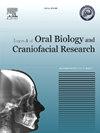Antifungal efficacy of chitosan-mediated fenugreek nanocomposite incorporated in tissue conditioner
Q1 Medicine
Journal of oral biology and craniofacial research
Pub Date : 2025-02-11
DOI:10.1016/j.jobcr.2025.01.007
引用次数: 0
Abstract
Introduction
The rough surface of dentures, coupled with xerostomia and immunosuppression, fosters microbial growth and colonization, with Candida albicans being a primary culprit. Tissue conditioners, used to reline ill-fitting dentures, can temporarily alleviate discomfort but are prone to microbial colonization. To address this, researchers have explored incorporating antifungal agents directly into tissue conditioners. Nanoparticles, particularly green-synthesized ones derived from fenugreek, have shown significant antifungal efficacy. Combining fenugreek extract with chitosan, can further improve antifungal outcomes due to its excellent drug delivery, mucoadhesive properties, and bioavailability.
Aim
To synthesize Chitosan mediated Fenugreek nanocomposite (1.5 %,2 %,2.5 % by weight concentrations) and evaluate its antifungal efficacy on heat cure denture base relined with tissue conditioner mixed with nanocomposite by assessing fungal colony formation after 1st day, 1st week and 2nd week.
Methodology
After synthesizing chitosan mediated fenugreek Nanocomposite, its characterization was performed using SEM, FTIR analysis and UV–Vis spectroscopy. Heat cure denture base discs coated with tissue conditioner-nanocomposite mixture were used to transfer fungal cultures onto Rose Bengal agar to assess colony formation.
Results and discussion
Chitosan-fenugreek nanoparticles were synthesized using the ionic gelation method, with fenugreek extract used for green synthesis. Kruskal-Wallis test showed significant effects over time, with 2.5 % group showing lowest fungal growth at 521 CFU/mL, followed by 2 % group at 587 CFU/mL, while the 1.5 % nanocomposite group still displayed considerable fungal growth.
Conclusion
Incorporating chitosan-mediated fenugreek nanocomposite into denture tissue conditioners offers a promising approach to reducing Candidal growth, potentially improving oral health outcomes for denture wearers.

壳聚糖介导的胡芦巴纳米复合材料在组织调节剂中的抗真菌作用
假牙表面粗糙,再加上口干和免疫抑制,促进微生物的生长和定植,白色念珠菌是罪魁祸首。组织调理剂,用于修复不合适的假牙,可以暂时缓解不适,但容易微生物定植。为了解决这个问题,研究人员已经探索将抗真菌剂直接加入组织护发素中。纳米颗粒,特别是从葫芦巴中提取的绿色合成纳米颗粒,已经显示出显著的抗真菌功效。胡芦巴提取物与壳聚糖结合使用,由于其良好的药物传递性、黏附性和生物利用度,可以进一步改善抗真菌效果。目的合成壳聚糖介导的胡芦巴纳米复合材料(按质量浓度分别为1.5%、2%、2.5%),并通过观察第1天、第1周、第2周的真菌菌落形成情况,评价其对热固化义齿基托的抑菌效果。方法合成壳聚糖介导的胡芦巴纳米复合材料,采用扫描电镜、红外光谱和紫外可见光谱对其进行表征。热固化义齿基托盘涂覆组织调理剂-纳米复合混合物,将真菌培养物转移到孟加拉玫瑰琼脂上,以评估菌落形成情况。结果与讨论采用离子凝胶法制备了壳聚糖-胡芦巴纳米颗粒,胡芦巴提取物为绿色合成原料。随着时间的推移,Kruskal-Wallis测试显示出显著的效果,2.5%组真菌生长最低,为521 CFU/mL,其次是2%组,为587 CFU/mL,而1.5%纳米复合材料组仍然显示出相当大的真菌生长。结论将壳聚糖介导的胡芦巴纳米复合材料应用于义齿组织调节剂中,有望减少念珠菌的生长,改善义齿佩戴者的口腔健康状况。
本文章由计算机程序翻译,如有差异,请以英文原文为准。
求助全文
约1分钟内获得全文
求助全文
来源期刊

Journal of oral biology and craniofacial research
Medicine-Otorhinolaryngology
CiteScore
4.90
自引率
0.00%
发文量
133
审稿时长
167 days
期刊介绍:
Journal of Oral Biology and Craniofacial Research (JOBCR)is the official journal of the Craniofacial Research Foundation (CRF). The journal aims to provide a common platform for both clinical and translational research and to promote interdisciplinary sciences in craniofacial region. JOBCR publishes content that includes diseases, injuries and defects in the head, neck, face, jaws and the hard and soft tissues of the mouth and jaws and face region; diagnosis and medical management of diseases specific to the orofacial tissues and of oral manifestations of systemic diseases; studies on identifying populations at risk of oral disease or in need of specific care, and comparing regional, environmental, social, and access similarities and differences in dental care between populations; diseases of the mouth and related structures like salivary glands, temporomandibular joints, facial muscles and perioral skin; biomedical engineering, tissue engineering and stem cells. The journal publishes reviews, commentaries, peer-reviewed original research articles, short communication, and case reports.
 求助内容:
求助内容: 应助结果提醒方式:
应助结果提醒方式:


